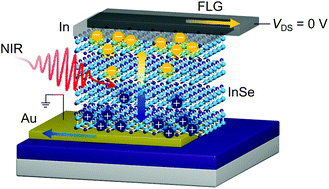Zero power infrared sensing in 2D/3D-assembled heterogeneous graphene/In/InSe/Au†
Abstract
Low- or self-powered infrared sensors can be used in a broad range of applications, including networking mobile edge devices and image recognition for autonomous driving technology. Here, we show state-of-the-art self-powered near-infrared (NIR) sensors using graphene/In/InSe/Au as a photoactive region. The self-powered NIR sensors show outstanding performance, achieving a photoresponsivity of ∼8.5 A W−1 and a detectivity of ∼1012 Jones at 850 nm light. Multiple self-powered InSe photodetectors with different device structures and contacts were systematically investigated. In particular, the asymmetrically assembled graphene/In/InSe/Au vertical heterostructure offers a high built-in field, which gives rise to efficient electron–hole pair separation and transit time that is shorter than the photocarrier lifetime. The built-in potential across the InSe was estimated using the Schottky barrier height at each metal contact with InSe, obtained using density functional theory calculations. We also demonstrate InSe vertical field-effect transistors and provide an out-of-plane carrier mobility of InSe. Using the out-of-plane mobility and structural parameters of each device, the built-in field, drift velocity, and corresponding transit time are estimated.



 Please wait while we load your content...
Please wait while we load your content...